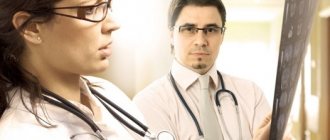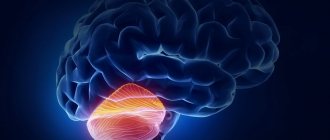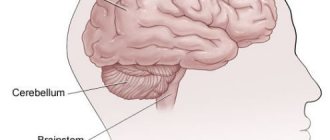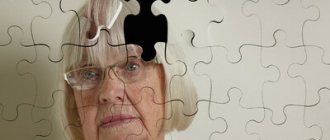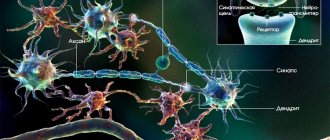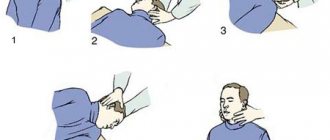Symptoms of cerebellar damage
When the cerebellum is damaged, motor function is impaired, tonic reflexes, motor reflexes, and locomotion (body movement in space) are impaired.
With unilateral damage to the cerebellum, the animal’s spine is bent in the direction of the damage, the eyeballs will deviate in the direction of the damage, and the head is also rotated in the direction of the damage. This is a violation of postural tonic reflexes. Such an animal is not able to move in a straight line. It makes rotational, maneuvering movements in the direction of damage. With bilateral damage to the cerebellum, the general condition becomes severe and may even lead to death.
There are 3 stages of cerebellar damage:
Stage 1 – the period of acute cerebellar insufficiency – is characterized by the absence of motor and reflex activity.
Stage 2 – loss of function – at this stage characteristic symptoms of cerebellar damage are revealed.
Stage 3 – compensation stage – symptoms of cerebellar damage become less pronounced and veiled. The functions of the cerebellum are compensated by the preserved parts of the cerebellum, as well as by other parts of the brain, for example, the cerebral cortex.
The consequences of cerebellar damage in humans were first described by the Italian scientist Luciani in 1823:
· Atony
– decreased muscle tone. In the first days of cerebellar damage, the tone of the extensor muscles is increased. After a few days, muscle tone decreases.
· Ataxic tremor
- manifests itself in trembling of the fingers and head. Voluntary motor activity is impaired.
· Ataxia
– impaired coordination of movements, inability to perform movements in the correct order and sequence. It is difficult for patients to walk, especially in the dark, they have to grab onto something with their hands; the gait resembles the gait of a drunken person: a person walks with his legs spread wide, staggering from side to side from the line of walking.
· Astasia
– impaired ability to maintain a standing or sitting posture. A synonym for “abazia” is the inability to stand or walk.
· Asynergy of movements
– violation of the sequence of complex movements, inability to activate muscles in different areas of the body in a certain order. If a patient in a standing position tries to tilt his head back, he may fall.
· Dysmetria
- violation of the direction of movement, inability to correctly assess the distance and, as a result, inability to immediately take the necessary object (for example, when trying to take a certain object from the table, the patient misses).
· Adiadochokinesis
– manifests itself in the inability to quickly perform alternating opposite movements.
· Dysarthria
– impaired coordination of facial muscles and rapid successive movements of the larynx, lips and respiratory system. Speech becomes slow, inexpressive, monotonous, chanted, and unintelligible.
· Dystonia
– inadequate redistribution of muscle tone.
· Asthenia —
rapid muscle fatigue.
· Intention tremor
- intensifying at the end of the movement, when the patient tries to touch an object, his hand trembles, making increasingly sweeping movements. Clinically tested is the finger-nose test - touching the tip of the nose with your index finger with your eyes closed.
· Cerebellar nystagmus
- oscillation of the eyeballs when trying to fix the gaze on any object when looking to the side.
The severity of these disorders is determined by the depth and location of the lesion. However, when the cerebellum is damaged, these changes do not always manifest themselves clearly, since with a slowly developing pathology they can be gradually compensated by other parts of the motor system of the central nervous system.
Instructions for performing laboratory work
Laboratory work No. 1.
Study of static reflexes in guinea pigs
Goal of the work:
Familiarize yourself with the methodology for studying reflexes.
To work you need:
a board measuring 10x10 cm, a napkin made of plastic film. The study is carried out on guinea pigs.
A) Postural reflexes.
Posture reflexes occur when the position of the head changes in relation to the body, which leads to the activation of vestibuloreceptors, proprioceptors of the neck muscles, and skin receptors of the neck. Afferent excitations from these receptors trigger reflex mechanisms of redistribution of muscle tone in the neck, torso, and limbs, aimed at the formation of a new adequate posture.
Rice. 9. Extension of the guinea pig's front legs after raising the head:
a – initial pose of the animal (before lifting); b – posture after rising
Progress:
place the guinea pig on a film napkin, study its natural pose: the front and hind legs are bent and brought towards the body, the head is oriented with the crown up; the head, neck and torso are located along the longitudinal axis of the body. Carefully lift the animal's head. Note that in this case the animal’s front legs are extended, while the back legs remain bent, which is due to the characteristics of a typical pose.
B) Setting (or straightening) reflexes.
These reflexes occur when normal posture is disrupted, for example when a guinea pig turns its body 180° (supine position) or 90° (side position). They represent a chain of tonic reflexes aimed at restoring normal posture.
Work progress: Straightening the head
is triggered from the receptors of the otolithic apparatus of the vestibular analyzer and from the skin receptors.
Lift the guinea pig up, holding it by the shoulder girdle. Rotate the torso relative to the longitudinal axis 180°, pressing the head with your fingers so that it is directed with the crown of the head downwards. Next, release your head, and it immediately assumes its normal position, turning the crown upward (Fig. 10). Move the guinea pig's body into a vertical position, head down, by holding it by the pelvis. Note that even under these conditions the head assumes its normal position - crown up.
Rice. 10. Restoring the natural position of the guinea pig’s head after turning the body along the longitudinal axis of the body by 180°:
a – rotation of the body by 180°, the head is fixed; b – the head is freed, straightened with the crown upward
Carefully lay the guinea pig on one side, pressing the head and body with your palm to the support plane (Fig. 11, a
);
hold it in this position until the animal calms down. Then release your head. The head takes its normal position - crown upward (Fig. 11, b
).
Straightening the torso
is triggered from proprioceptors of the muscles and tendons of the neck, skin receptors of the torso on the muscles of the torso and limbs.
Lay the guinea pig on one side, pressing the head and body with your palm. Then release the head and shoulder girdle - the head turns with the crown upward, followed by the front part of the body. After this, release the back of your torso. Note that the animal takes a natural pose, rising on its legs and turning its body 90° with its back up (Fig. 11, c
).
Rice. 11. Restoring the natural position of the guinea pig’s head and body after turning the body by 90°:
a – the body is turned 90°, the animal lies on its side, the head and body are pressed with the palm of the hand; b – the head is freed, straightened; c – the body is freed, straightened
Lift the guinea pig up. Turn her back down and release her. Providing the opportunity for free fall. The animal's head immediately returns to its original position; after it, the front part of the body and the front legs turn, then the pelvis and hind legs. The animal flips 180º in the air and lands on all four legs.
Conclusion:
Describe the parts of the reflex arc of each reflex. Describe the functional role of postural reflexes and righting reflexes.
Laboratory work No. 2
Statokinetic reflexes
Goal of the work:
Familiarize yourself with the methodology for studying reflexes.
To work you need:
a board measuring 10x10 cm, a napkin made of plastic film. The study is carried out on guinea pigs.
Statokinetic reflexes arise as a result of active and passive movement of the body in space and are aimed at maintaining balance. Depending on the nature of the movement, these reflexes are divided into two subgroups:
1. arising under the influence of linear acceleration during translational motion;
2. arising under the influence of angular acceleration during rotation.
A) Statokinetic reflexes arising under the influence of linear acceleration.
Examples of reflexes of this type are the descent and ascent reflexes (“elevator” reflexes), landing reflexes. They are caused by irritation of the receptors of the otolith apparatus and partly the receptors of the semicircular canals.
Work progress: Elevator reflexes.
Place the guinea pig on the board, study its posture: the front and hind legs are bent, the head is raised (Fig. 12,
a
).
Quickly move the animal along with the plank, first down and then up. Notice how the position of its body, head and legs changes: at the beginning of a rapid descent, the guinea pig's front and hind legs straighten, and the body and head rise (Fig. 12, b
).
At the moment of a sudden stop at the end of the descent, the paws are bent, the head and torso are pressed in the plane of the support (Fig. 12, c
). When rising, the described reflex reactions occur in the reverse order.
Rice. 12. Changing the guinea pig's posture during a rapid descent:
a – initial pose; b – posture at the beginning of a rapid descent; c – posture at the moment of sudden cessation of descent
Rice. 13. Changing the posture of a guinea pig when moving quickly forward (with support):
a – initial pose; b – by
behind at the moment of moving forward
Landing reflex.
Lift the animal and hold it in the air: the guinea pig's paws in this situation are half-bent. Quickly move the animal towards the ground. Note that during movement, the animal's front and rear legs unbend and stretch forward, and the toes fan out - the landing reflex. At the moment of landing (collision with the ground), the limbs spring and protect the head and body of the animal from hitting the ground.
Similar changes in the position of the limbs are observed in a guinea pig if it is placed on a table and quickly moved forward (Fig. 13).
B) Statokinetic reflexes arising under the influence of angular acceleration.
To work you need:
swivel chair, large funnel. The study is carried out on a frog.
Progress:
Place the frog on the swivel chair and cover it with a large funnel on top. Rotate the chair quickly. Check. That at the beginning of the rotation, when the effect of positive angular acceleration takes effect, the frog's head turns in the direction opposite to the direction of rotation. Following the head, the torso bends in the same direction. It is often possible to observe how, in response to positive angular acceleration, a frog crawls in a circle in the direction opposite to the direction of rotation. After the rotation is completed, the frog's original position is restored.
Similar changes in the position of the limbs are observed in a guinea pig if it is placed on a table and quickly moved forward (Fig. 39).
Conclusion:
Indicate the receptive fields of these reflexes and characterize their biological role.
Laboratory work No. 3
